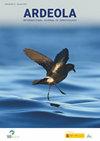大斑杜鹃幼鸟的生存、扩散和初始迁徙运动
IF 1.2
4区 生物学
Q2 ORNITHOLOGY
引用次数: 0
摘要
总结。大斑点布谷鸟属于布谷鸟科,多年来,人们对布谷鸟的生物学进行了深入的研究,特别是在鸟类幼虫寄生的背景下。然而,在其生物学知识方面仍有重要的空白。最近的研究强调了关于幼鱼生存、扩散和迁徙路线的信息缺失,本研究的主要目的是为了填补这一空白。我们利用无线电发射机和卫星标签(PTTs)研究了大斑杜鹃幼鸟在研究区域(即繁殖区域)的初始运动,以及它们的长距离迁徙运动。我们发现,在研究区域,很大一部分有标记的个体在离开巢穴的几天或几周内死亡,直接和间接的证据表明,捕食是死亡的主要原因。我们的研究结果表明,幼鱼在离开伊比利亚半岛之前进行的迁徙前运动与之前发现的有经验的成鱼不同。研究区域的高捕食率意味着13只卫星标记的幼鱼中只有3只开始迁徙到撒哈拉以南非洲的越冬地区,使用东大西洋路线。总的来说,这里提供的信息有助于更好地了解幼年大斑杜鹃的生物学,并可能对解决未来潜在的保护问题有用。-Martínez-Zunzarren, N., Ruiz-Raya, F., psamurez - contreras, T., Soler, M. & Ibáñez-Álamo, J.D.(2023)。大斑杜鹃幼鸟的生存、扩散和初始迁徙运动。农业学报,70:59-74。Resumen。El críalo europeo Clamator glandarius es un ave perteneciente a la familia Cuculidae cuya biología se ha estudiado intensamente durante años, sobre en El contexto del parasitismo de cría。在禁运中,todavía存在着重要的lagunas,特别是在经济上,biología de esta。estudio接收了两项申请,一项是关于《社会主义宣言》的申请,一项是关于《社会主义宣言》的申请,一项是关于《社会主义宣言》的申请,一项是关于《社会主义宣言》的申请,一项是关于《社会主义宣言》的申请,一项是关于《社会主义宣言》的申请,一项是关于《社会主义宣言》的申请。Para ello,利用无线电发射机与PTT的通信,分别在área de cría, así和críalo欧洲的少年长距离迁徙的通信中,利用无线电发射机与PTT的通信,分别在área de cría和así欧洲的少年长距离迁徙。关于死亡的主要原因的联合调查:关于死亡的主要原因的联合调查:área关于cría死亡的主要原因的联合调查:días关于死亡的主要原因的联合调查:直接证据和间接证据:depredación关于死亡的主要原因。未成年人迁移前的新行为(例如,未成年人迁移前的新行为,成年人迁移前的新行为,成年人迁移前的新行为,成年人迁移前的新行为,成年人迁移前的新行为,成年人迁移前的新行为,成年人迁移前的新行为,成年人迁移前的新行为。1 .在África撒哈拉以南地区,1 .在África撒哈拉以南地区,1 .在África撒哈拉以南地区,1 .在Atlántico东部地区,1 .在Atlántico东部地区,1 .在Atlántico东部地区,1 .在Atlántico东部地区,1 .在mayoría地区,1 .在mayoría地区,1 .在mayoría地区,1 .在mayoría地区,1 .在sólo地区,3 .在sólo地区,13个人,1 .在cría地区,1 .在África地区,1 .在Atlántico东部地区,1 .在mayoría地区,1 .在Atlántico东部地区,1 .在cría地区,1 .在Atlántico东部地区,1 .在cría地区,1 .在cría地区,1 .在Atlántico东部地区。总的来说,la información proporcionada or nusterstertrabajo贡献了一个主要的comprensión de la biología de los juvenile de esta,特别是podría ser útil para bordar los possible problemas de conservación a los que pueda enfrense En el futures。-Martínez-Zunzarren, N., Ruiz-Raya, F., psamurez - contreras, T., Soler, m.e Ibáñez-Álamo, J.D.(2023)。监察,dispersión y。农业学报,70:59-74。本文章由计算机程序翻译,如有差异,请以英文原文为准。
Survival, Dispersal and Initial Migratory Movements of Juvenile Great Spotted Cuckoos Clamator glandarius
Summary. The Great Spotted Cuckoo Clamator glandarius belongs to the family Cuculidae, whose biology has been intensively studied for years, particularly in the context of avian brood parasitism. However, there are still important gaps in knowledge of its biology. Recent studies have highlighted the absence of information about survival, dispersal and migratory routes of juveniles, and the main aim of this study was to contribute to filling this gap. We used radio-transmitters and satellite tags (PTTs) to study the initial movements of juvenile Great Spotted Cuckoos in the study area (i.e. breeding territories), as well as their long-distance migratory movements. We found that a large proportion of marked individuals died in the study area within days or weeks of leaving the nest, with direct and indirect evidence suggesting that predation is the main cause of mortality. Our results suggest that pre-migratory movements of juveniles, i.e., those carried out before leaving the Iberian Peninsula, are different from those previously found for experienced adults. The high predation rate in the study area meant that only three of 13 satellite-tagged juveniles initiated migration to their wintering area in sub-Saharan Africa, using the Eastern Atlantic route. Overall, the information provided here contributes to a better understanding of the biology of juvenile great Spotted Cuckoos and could be useful in addressing potential future conservation problems.—Martínez-Zunzarren, N., Ruiz-Raya, F., Pérez-Contreras, T., Soler, M. & Ibáñez-Álamo, J.D. (2023). Survival, dispersal and initial migratory movements of juvenile Great Spotted Cuckoos Clamator glandarius. Ardeola, 70: 59-74. Resumen. El críalo europeo Clamator glandarius es un ave perteneciente a la familia Cuculidae cuya biología se ha estudiado intensamente durante años, sobre todo en el contexto del parasitismo de cría. Sin embargo, todavía existen importantes lagunas en el conocimiento de la biología de esta especie. Estudios recientes han puesto de manifiesto la ausencia de información sobre la supervivencia, la dispersión y las rutas migratorias en los juveniles de esta especie, por lo que el objetivo principal de este estudio es contribuir a llenar este vacío. Para ello, utilizamos radiotransmisores y emisores satélite tipo PTT para estudiar tanto los primeros movimientos en el área de cría, así como los movimientos migratorios de larga distancia de los juveniles de críalo europeo, respectivamente. Comprobamos que una parte importante de los individuos marcados murieron en el área de cría pocos días después de abandonar el nido, con evidencias directas e indirectas que apuntan a la depredación como la principal causa de mortalidad. Nuestros resultados sugieren que los movimientos premigratorios de los juveniles (es decir, los movimientos realizados antes de abandonar la península ibérica) son relativamente diferentes a los encontrados anteriormente para los adultos de esta especie. La elevada tasa de depredación impidió que la mayoría de los cucos juveniles llegaran a su zona de invernada en el África subsahariana, y sólo 3 de los 13 individuos marcados por satélite lograron abandonar la zona de cría y se desplazaron a África utilizando la ruta del Atlántico oriental. En general, la información proporcionada por nuestro trabajo contribuye a una mejor comprensión de la biología de los juveniles de esta especie y podría ser útil para abordar los posibles problemas de conservación a los que pueda enfrentarse en el futuro.—Martínez-Zunzarren, N., Ruiz-Raya, F., Pérez-Contreras, T., Soler, M. e Ibáñez-Álamo, J.D. (2023). Supervivencia, dispersión y movimientos migratorios iniciales de los juveniles de críalo europeo Clamator glandarius. Ardeola, 70: 59-74.
求助全文
通过发布文献求助,成功后即可免费获取论文全文。
去求助
来源期刊
CiteScore
2.30
自引率
6.20%
发文量
16
审稿时长
>12 weeks
期刊介绍:
Ardeola: International Journal of Ornithology is the scientific journal of SEO/BirdLife, the Spanish Ornithological Society. The journal had a regional focus when it was first published, in 1954. Since then, and particular during the past two decades, the journal has expanded its thematic and geographical scope. It is now a fully international forum for research on all aspects of ornithology. We thus welcome studies within the fields of basic biology, ecology, behaviour, conservation and biogeography, especially those arising from hypothesis-based research. Although we have a long publication history of Mediterranean and Neotropical studies, we accept papers on investigations worldwide.
Each volume of Ardeola has two parts, published annually in January and July. The main body of each issue comprises full-length original articles (Papersand Review articles) and shorter notes on methodology or stimulating findings (Short Communications). The publication language is English, with summaries, figure legends and table captions also in Spanish. Ardeolaalso publishes critical Book Reviewsand PhD-Dissertation Summaries; summarising ornithological theses defended in Spain. Finally there are two Spanish-language sections, Ornithological News; summarising significant recent observations of birds in Spain, and Observations of Rare Birds in Spain, the annual reports of the Spanish Rarities Committee.

 求助内容:
求助内容: 应助结果提醒方式:
应助结果提醒方式:


